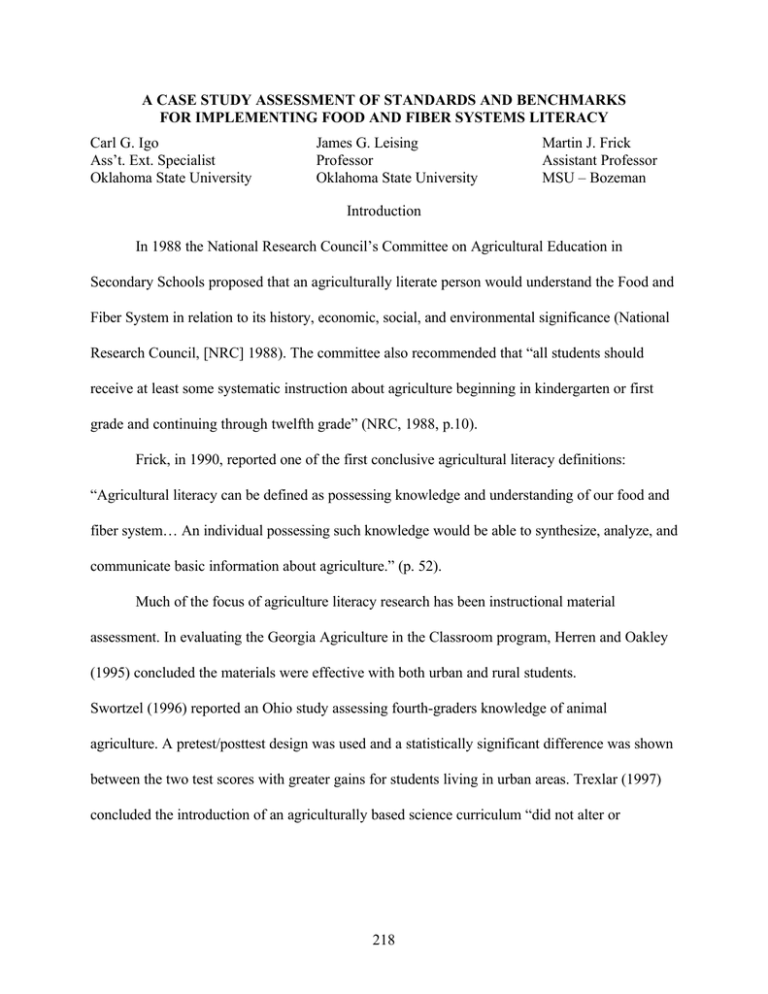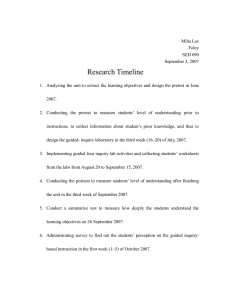FOR IMPLEMENTING FOOD AND FIBER SYSTEMS
advertisement

A CASE STUDY ASSESSMENT OF STANDARDS AND BENCHMARKS FOR IMPLEMENTING FOOD AND FIBER SYSTEMS LITERACY Carl G. Igo Ass’t. Ext. Specialist Oklahoma State University James G. Leising Professor Oklahoma State University Martin J. Frick Assistant Professor MSU – Bozeman Introduction In 1988 the National Research Council’s Committee on Agricultural Education in Secondary Schools proposed that an agriculturally literate person would understand the Food and Fiber System in relation to its history, economic, social, and environmental significance (National Research Council, [NRC] 1988). The committee also recommended that “all students should receive at least some systematic instruction about agriculture beginning in kindergarten or first grade and continuing through twelfth grade” (NRC, 1988, p.10). Frick, in 1990, reported one of the first conclusive agricultural literacy definitions: “Agricultural literacy can be defined as possessing knowledge and understanding of our food and fiber system… An individual possessing such knowledge would be able to synthesize, analyze, and communicate basic information about agriculture.” (p. 52). Much of the focus of agriculture literacy research has been instructional material assessment. In evaluating the Georgia Agriculture in the Classroom program, Herren and Oakley (1995) concluded the materials were effective with both urban and rural students. Swortzel (1996) reported an Ohio study assessing fourth-graders knowledge of animal agriculture. A pretest/posttest design was used and a statistically significant difference was shown between the two test scores with greater gains for students living in urban areas. Trexlar (1997) concluded the introduction of an agriculturally based science curriculum “did not alter or 218 negatively effect student perceptions of science, agriculture, or their agri-science knowledge level” (p. 19). Nunnery (1996) noted the necessity for building a literacy framework for understanding agriculture’s perspectives and viewpoints. Leising and Zilbert (1994) approached agricultural literacy from this angle. They developed a systematic curriculum framework identifying what students should know or be able to do. The Food and Fiber Systems Literacy Framework explained what an agriculturally literate high school graduate should comprehend. Using a series of standards in five thematic areas, the framework delineated the necessary components for understanding the way food and fiber systems relates to daily life. Breaking the standards into grade-grouped benchmarks, K-1, 2-3, 4-5, and 6-8, the Framework provided a systematic means of addressing agricultural literacy. One point of contention was the most appropriate and least intrusive way to incorporate instruction into an already overloaded curriculum. (Law, 1990). The Food and Fiber Systems Literacy Framework was designed to make connections to agricultural concepts through existing curriculum. The research problem was whether education about agriculture effectively can be infused into core academic learning using the Food and Fiber Systems Literacy Framework as the guide for instruction. Purpose and Objectives The purpose of this study was to assess food and fiber knowledge of selected students in kindergarten through eighth grade before and after receiving instruction based upon the Food and Fiber Systems Literacy (FFSL) Framework standards and benchmarks. For the three case studies of this research, the specific objectives included: 219 1. Assess students’ knowledge of Food and Fiber Systems before and after receiving instruction based upon the FFSL Framework. 2. Determine differences by grade grouping (K-1, 2-3, 4-5, 6-8) in student knowledge about agriculture before and after instruction based upon the FFSL Framework. 3. Determine grade-grouping differences in student knowledge about agriculture before and after instruction based upon the five thematic areas of the FFSL Framework. 4. Determine if a relationship existed between the differences in student knowledge about agriculture before and after instruction based upon the FFSL Framework and the number of teacher reported instructional connections to the Framework. Methods and Procedures The study included one K-8 school in California, Montana, and Oklahoma. The sites were chosen based on diversity and school size. The case studies included 366 students, 177 students, and 257 students, respectively. The Montana and Oklahoma cases involved kindergarten through eighth grade students and teachers. The California study included students and teachers from first, second, third, fourth, seventh, and eighth grades. Each site used an infusion approach, with teachers integrating FFSL instruction into core academic subjects. Instruments were developed to measure FFSL knowledge for each grade grouping in the Framework: K-1, 2-3, 4-5, and 6-8. Questions on each instrument were based on the gradegrouped benchmarks. The K-1 and 2-3 instruments included 16 and 21 items respectively. The 45 and 6-8 grade level instruments contained 35 and 30 text-responses respectively. Educators and agriculturalists reviewed the instruments for content validity. The reliability coefficients for the four instruments ranged from 0.7763 to 0.9469. 220 Participating teachers administered the pre-test during the first week of October 1997, prior to any FFSL instruction. The teachers administered the post-test during the week of May 5, 1998. Feedback regarding the connections made to the Framework was solicited from the teachers throughout the project year. Test mortality accounted for 193 fewer students tested in California, 14 fewer students tested in Montana, and 11 fewer students tested in Oklahoma. Analysis of variance procedures were used to determine differences in pretest and posttest knowledge scores and to delineate differences by theme area of the FFSL Framework. A Pearson’s Product Moment Correlation was computed to assess relationships between pre- and posttest differences and the number of teacher reported instructional connections to the Framework. Results/Findings Pretest and Posttest Grade Grouping Analysis The pretest and posttest food and fiber knowledge scores for students were reported in Tables I, II, and III. Each table provides pre- and posttest score differences and the significance levels for those differences. Table I provides the results from the California test site. The K-1 scores increased 2.5 points while the 2-3 scores increased 5.8 points. Both third-fourth-combination teachers gave the 2-3 test to all students in their classes thus there was no 4-5 component. Also, without a participating sixth grade, the 6-8-grade grouping included only seventh and eighth graders. Within this group, the mean score dropped 2.5 points. Both the 2-3 and the 6-8-grade group returned statistically significant pre- and posttest score differences. 221 Table I California Students’ Food and Fiber Knowledge Levels As Measured By Pretest And Posttest Scores Pretest n Mean 15 54.8 42 71.0 Posttest n Mean 12 57.3 39 76.8 Grade K-1 2-3 4-5a 6-8b 502 31.8 315 Note. df for all calculations was 1. a There was no 4-5 component in CA 29.3 Difference +2.5 +5.8 F-value 0.86 8.83 p 0.3555 0.0032* -2.5 21.45 0.0001* *p<0.05 b There were no 6th grade participants in CA Table II illustrates the data from the Montana site. The mean score for the K-1 grade group increased almost 17 points. The 2-3 group the mean score increased almost 14 points and the 4-5-grade group mean score increased four points. The 6-8-grade group mean decreased 1.3 points. All grade groups except 6-8 showed statistically significant differences in pre- and posttest knowledge scores. Table II Montana Students’ Food and Fiber Knowledge Levels As Measured By Pretest And Posttest Scores Pretest Grade n Mean K-1 54 72.1 2-3 38 75.6 4-5 49 67.2 6-8 50 63.7 Note. df for all calculations was 1. Posttest n Mean 50 88.8 35 89.4 47 71.2 45 62.4 222 Difference +16.7 +13.8 +4.0 -1.3 *p<0.05 F-value 74.75 46.28 5.13 0.23 p 0.0001* 0.0001* 0.0239* 0.6315 Table III provides the pretest and posttest data for the Oklahoma site. The K-1 group mean score increased almost nine points, and the 2-3 group mean increased just over nine points. The posttest mean score increased 6.6 points at grade grouping 4-5, while the 6-8-grade group posttest score decreased almost three points. Once again, all grade groups except 6-8 showed statistically significant pre- and posttest knowledge score differences. Table III Oklahoma Students’ Food And Fiber Knowledge Levels As Measured By Pretest And Posttest Scores Pretest Grade n Mean K-1 53 77.3 2-3 73 79.3 4-5 75 66.1 6-8 67 57.9 Note. df for all calculations was 1. Posttest n Mean 53 86.1 72 88.4 74 72.7 58 55.0 Difference +8.8 +9.1 +6.6 -2.9 *p < 0.05 F-value 21.33 41.24 15.11 1.53 p 0.0001* 0.0001* 0.0001* 0.2157 Thematic Area Analysis The FFSL Framework was organized around five thematic areas: Food and Fiber Systems—Understanding Agriculture; History, Culture, and Geography; Science—Agricultural and Environmental Interdependence; Business and Economics; and Food, Nutrition, and Health. With each site using an infusion approach to implementing FFSL, the data were combined to provide a composite view of the thematic area analysis. That composite information was presented in Table IV. With only two exceptions, all grade groups within each theme area showed statistically significant differences between pre- and post test results. Within the Science and Environment theme, the 2-3 grade-group produced a zero F-value, which yielded a 0.98 223 significance score. The 6-8 group, within the Business and Economics theme, also showed no statistical significance, producing an F-value of less than one. 224 Table IV F-Value Comparison Of Composite Pretest And Posttest Differences By Grade Groups Within Theme Areas For California, Montana, and Oklahoma Sites Theme and group F-value Understanding Agriculture K-1 15.5 2-3 11.01 a 4-5 42.71 6-8 19.54 History, Culture, and Geography K-1 1108.58 2-3 33.33 4-5a 52.83 6-8 290.48 Science and Environment K-1 202.96 2-3 0.00 a 4-5 79.96 6-8 14.09 Business and Economics K-1 4.80 2-3 22.56 4-5a 18.76 6-8 0.40 Food, Nutrition, and Health K-1 59.88 2-3 145.27 4-5a 24.21 6-8 5.92 Note. df for all calculations was 1. *p < 0.05 a there was no 4-5 component in CA – data represent only MT and OK p 0.0001* 0.0001* 0.0001* 0.0001* 0.0001* 0.0001* 0.0001* 0.0001* 0.0001* 0.9820 0.0001* 0.0002* 0.0295* 0.0001* 0.0001* 0.5254 0.0001* 0.0001* 0.0001* 0.0151* Correlation Analysis Pearson’s Product Moment Correlation Coefficients were computed to assess whether a relationship existed between the knowledge score differences and the number of instructional connections teachers made to Food and Fiber Systems. Table V indicates the result of the analysis. Both the Montana site and the Oklahoma site showed a strong correlation, 0.621 and 225 0.586 respectively, between the test score differences and the number of instructional connections made by teachers, with the Oklahoma site returning a significant statistical difference. Pooling the Montana and Oklahoma data to create a composite yielded a 0.603 correlation coefficient and the computed difference was statistically significant as well. Knowledge score increases of 10 percent or better were seen when the number of reported connections rose to 20 or above. California data were not included in the correlation due to structural differences between the California school and the other two schools. The California school did not include all grade levels and was based on a village concept. The California teachers did submit reports, however the village concept prevented applicable correlations between a particular group or class of students and the number of instructional connections those students received. Table V Correlation Of Differences In Pretest And Posttest Scores To Instructional Connections By Site Site Montana Oklahoma Composite *p < 0.05 n 8 13 21 reported connections 14-28 5-27 5-28 Pearson r 0.621 0.586 0.603 p 0.1003 0.0353* 0.0038* Major Findings Objective 1. California students had a cursory knowledge of Food and Fiber Systems prior to receiving instruction, with pretest grade-grouped mean scores ranging from 32 to 71 percent. Scores increased minimally from pretest to posttest, with posttest mean scores ranging from 29 to 77 percent. 226 Prior to receiving instruction based upon Food and Fiber Systems, students in Montana had some knowledge of agriculture, with pretest grade-grouped mean scores ranging from 64 to 76 percent. Grade-grouped mean scores were generally higher, 62 to 89 percent, after receiving instruction. Oklahoma students also had some knowledge of Food and Fiber Systems with pretest means ranging from 58 to 79 percent for the four grade groupings. Posttest means were higher in all but the 6-8-grade group, ranging from 55 to 88 percent. Objective 2. The California students posttest scores for grade groups K-1 and 2-3 were higher than pretest scores, with the 2-3 group scores significantly different at the 0.05 level. Both the Montana students’ and Oklahoma students’ posttest scores were higher than pretest scores for grades K-5, and each group was statistically significant. The posttest scores for 6-8 at each site were lower than pretest scores, with the California groups’ scores showing statistically significant difference. Objective 3. Statistically significant pre- and posttest mean differences were found in grade-groupings across all five thematic areas of the FFSL Framework. In three theme areas those differences occurred across all grade-groups. The Science and Environment theme showed no statistical significance at the 2-3 grade group and the Business and Economics theme showed no significance at the 6-8 grade group. Objective 4. Teacher reported connections to the FFSL Framework ranged from 5 to 28 in the Montana and Oklahoma case studies. There was a statistically significant correlation between pre- and posttest score differences and the number of teacher reported instructional connections in 227 Oklahoma. The correlation of score differences to composite teacher reported instructional connections was also statistically significant. Conclusions The conclusions were not to be generalized beyond the case studies within this research. Examination and analysis of the major findings for each objective led to the following conclusions: 1. Students at each site had some knowledge of Food and Fiber Systems prior to the study. 2. In each case study, it was possible to increase student knowledge about agriculture by infusing instruction based upon the FFSL Framework standards and benchmarks. 3. It was possible to infuse education about agriculture into core academic learning using the FFSL Framework’s five thematic areas as the guide for instruction. 4. A positive relationship existed between the number of connections teachers made to the FFSL Framework and increases in student knowledge. Recommendations Based upon the conclusions and major findings of the research, the following recommendations were made: 1. As a means of assessing changes in student knowledge about Food and Fiber Systems, agricultural literacy instructional materials should be linked to the FFSL standards and benchmarks. 2. There is a need for inservice training of teachers at all grade levels to assist them in making relevant connections between core academic instruction and FFSL. 228 3. Further investigation is needed to understand how FFSL standards and benchmarks effectively can be infused into departmentalized instruction found in middle, junior, and senior high schools. 4. Subsequent studies should incorporate an experimental or quasi-experimental design with larger student populations to better understand the relationship between teaching and learning and the FFSL Framework. Implications The conclusions from this study showed that the FFSL Framework effectively can be used to guide instruction about agriculture. Discussions among agricultural literacy professionals, agriculture educators, curriculum specialists, state education leaders, and local educators must focus on agricultural literacy as the common goal. To accomplish that goal, consensus agreement must be reached on the definition and scope of agricultural literacy. The use of the FFSL Framework with its standards and benchmarks provides an opportunity to engage the stakeholders in a dialogue toward attaining that goal. The whole-school setting for implementing FFSL instruction works to create a synergy among teachers, administrators, students, and parents. That synergy may lead to greater overall student achievement and increase the chances of sustaining infusion of Food and Fiber Systems standards across curriculums. References Frick, M.J. (1990). A definition and the concepts of agricultural literacy: A national study. Unpublished doctoral dissertation, Iowa State University, Ames. 229 Herren, R.V. & Oakley, P. (1995). An evaluation of Georgia Agriculture in the Classroom program. Journal of Agricultural Education, 36 (4), 26-31. Law, D.A. (1990). Implementing agricultural literacy programs. Agricultural Education Magazine, 62 (9), 5-6, 22. Leising, J.G. & Zilbert, E.E. (1994). Validation of the California agriculture literacy framework. Proceedings of the National Agricultural Education Research Meeting, USA, 21, 112-119. National Research Council, Board on Agriculture, Committee on Agricultural Education in Secondary Education. (1988) Understanding agriculture: New directions for agricultural education. Washington, D.C.: National Academy Press. Nunnery, S. (1996). Ag-outside-the-classroom: The citizens’agenda. The Agricultural Education Magazine 68 (3), 12-13,24. Swortzel, K.A. (1996). Systematic educational efforts teaching about agriculture and the effect on fourth-grade students knowledge of animal agriculture in Ohio. Proceedings of the National Agricultural Education Research Meeting, USA, 23, 163-172 Trexlar, C. (1997). The cheeseburger came from where?: Elementary school student’s understanding of how food is affected by biology and climate. Proceedings of the National Agriculture Research Meeting, USA, 24, 23-33. 230 A CASE STUDY ASSESSMENT OF STANDARDS AND BENCHMARKS FOR IMPLEMENTING FOOD AND FIBER SYSTEMS LITERACY - A Critique Linda Whent, University of California, Davis The authors should be commended for conducting a timely and extensive study to assess the food and fiber knowledge of students in kindergarten through 8th grade before and after receiving instruction based on the Food and Fiber Systems Literacy Framework. Theoretical Framework – The authors have provided a thorough discussion of the background and need for the study. An appropriate theoretical base was selected for the research. The purpose and objectives of the research were clearly stated and presented. Methodology – The study included two cases: populations from schools included 177 students from a Montana school community and 257 students from an Oklahoma school community. The study focused on K – 8 grades. It was not clear that two schools from each community were part of the case study until the school profiles were presented in the results section. The researchers should be commended for their time and efforts in developing knowledge instruments for multiple grade levels. Instruments were validated by experts, pilot tested, and revised. Adequate to excellent reliability coefficients were reported. Extensive teacher training, preparation, and support were provided by the researchers to help increase the internal validity of the study. Findings – Formative feedback, qualitative, and quantitative data were collected. Both case studies used static populations. The researchers state that the conclusions were not to be generalized beyond the case studies within the research. Inferential statistics are only used when sample data is generalized to a larger population. Only means and standard deviations of the populations needed to be presented. It was interesting to find that test scores of grades K – 5 increased and scores of grades 6 – 8 decreased in both case studies. The summary of major findings was helpful in compiling the many findings of this study Conclusions and Practical Importance – The findings, recommendations, and implications were clearly presented. Could one conclude that, in these case studies, students in lower grades received the greatest benefits from agriculture literacy instruction? Do these findings support arguments of teaching agricultural literacy in lower grades? Are certain agricultural subject or theme areas better taught at specific grade levels? Since students in both case studies had previous agricultural knowledge, should we question if the instructional materials at the 6- 8 grade levels provided new or challenging information? The researchers should be commended for an excellent study. Due to the scope, sophistication, and length of this study, I recommend that it be published as two papers: possibly, Objectives 1 through 3 in one paper and Objectives 4 and 5 in the other. 231



